9.20.2023
The Cultural History of Godzilla Introduction – Pt 74
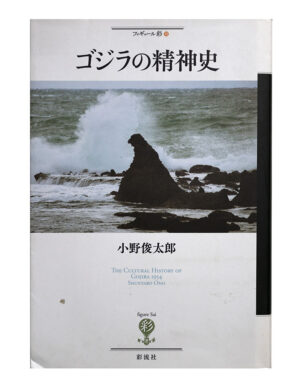
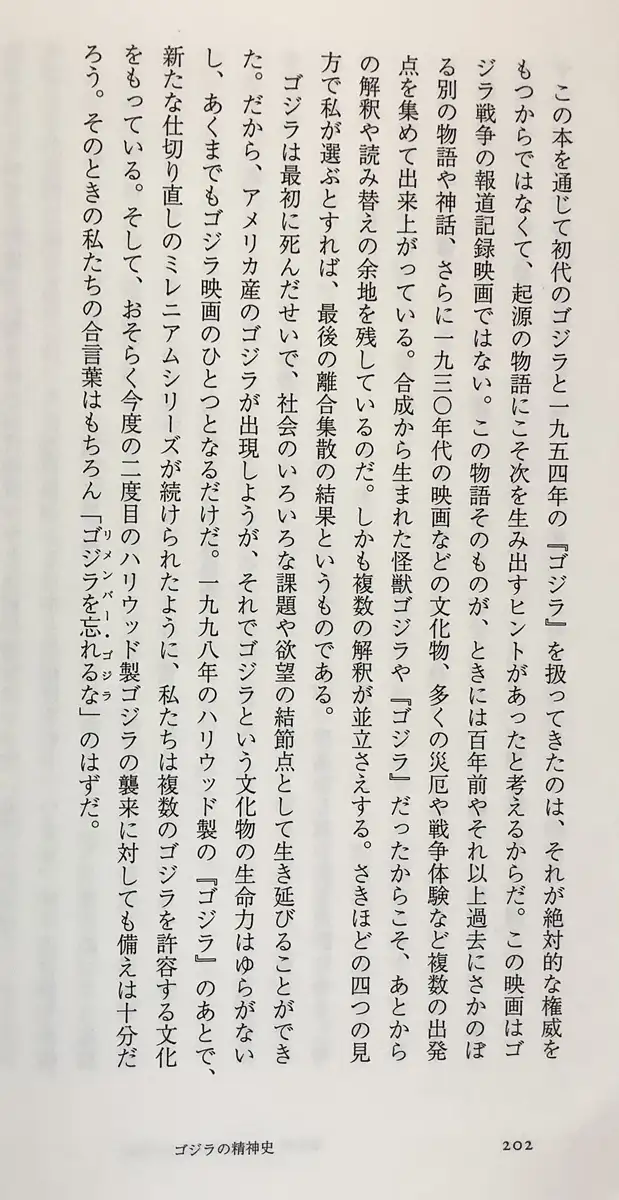
P 202
この本を通じて初代のゴジラと一九五四年の『ゴジラ』を扱ってきたのは、それが絶対的な権威をもつからではなくて、起源の物語にこそ次を生み出すヒントがあったと考えるからだ。この映画はゴジラ戦争の報道記録映画ではない。この物語そのものが、ときには百年前やそれ以上過去にさかのぼる別の物語や神話、さらに一九三〇年代の映画などの文化物、多くの災厄や戦争体験など複数の出発点を集めて出来上がっている。合成から生まれた怪獣ゴジラや『ゴジラ』だったからこそ、あとからの解釈や読み替えの余地を残しているのだ。しかも複数の解釈が並立さえする。さきほどの四つの見方で私が選ぶとすれば、最後の離合集散の結果というものである。
Throughout this book, I have dealt with the first Godzilla and the 1954 Godzilla, not because they have absolute authority, but because I believe that the origin story holds hints for the next generation. This film is not a documentary film about the Godzilla war. The story itself is made up of multiple starting points, including other stories and myths that sometimes date back a hundred years or more, cultural artifacts such as movies from the 1930s, and many disasters and war experiences. Because “Godzilla,” the monster Godzilla, was created through synthesis, it leaves room for later interpretation and rereading. Moreover, there are even multiple interpretations. If I had to choose between the four views mentioned earlier, it would be the result of the final dissociation and dispersion.
ゴジラは最初に死んだせいで、社会のいろいろな課題や欲望の結節点として生き延びることができた。だから、アメリカ産のゴジラが出現しようが、それでゴジラという文化物の生命力はゆらがないし、あくまでもゴジラ映画のひとつとなるだけだ。一九九八年のハリウッド製の『ゴジラ』のあとで、新たな仕切り直しのミレニアムシリーズが続けられたように、私たちは複数のゴジラを許容する文化をもっている。そして、おそらく今度の二度目のハリウッド製ゴジラの襲来に対しても備えは十分だゴジラろう。そのときの私たちの合言葉はもちろん「ゴジラを忘れるな」のはずだ。
Because Godzilla died first, he was able to survive as a nexus of society’s various issues and desires. Therefore, even if an American Godzilla were to appear, the vitality of Godzilla as a cultural object would remain unchanged, and it would just be another Godzilla movie. We have a culture that tolerates multiple Godzillas, as Hollywood’s 1998 Godzilla was followed by a new reboot of the Millennium series. And Godzilla is probably well prepared for the second Hollywood-made Godzilla attack. Our slogan at that time was, of course, “Don’t forget Godzilla.”
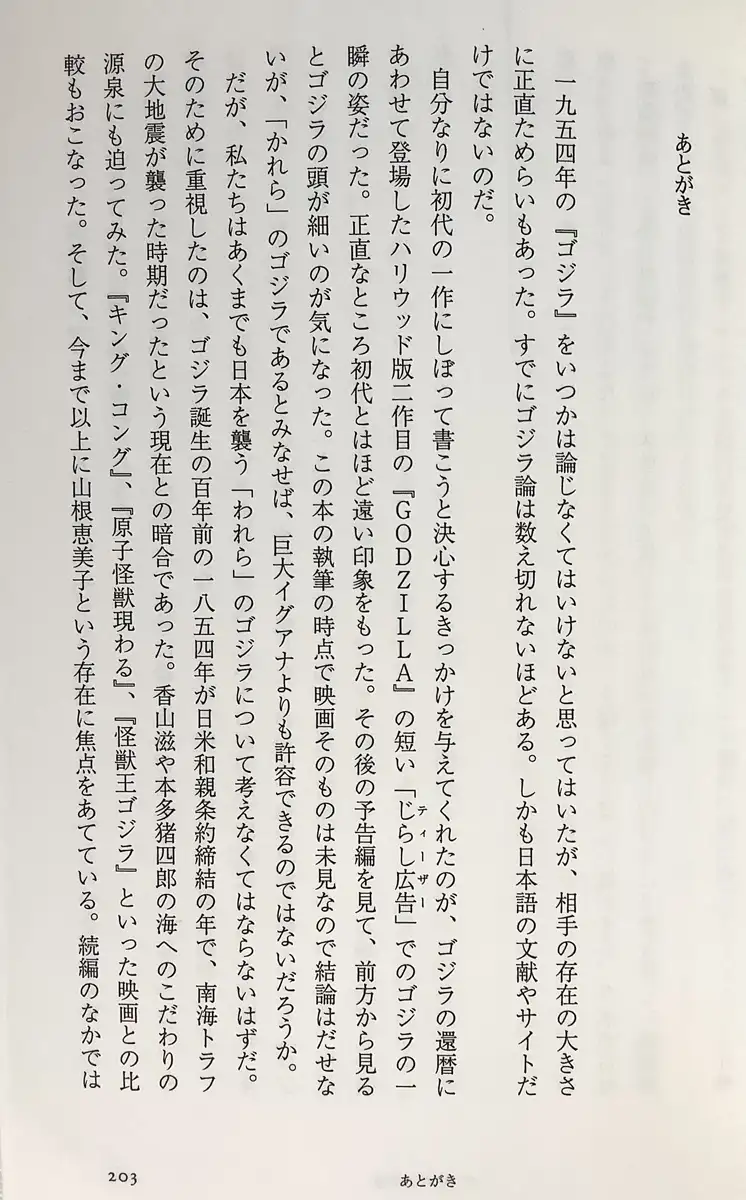
P 203
あとがき
Afterword
一九五四年の『ゴジラ』をいつかは論じなくてはいけないと思ってはいたが、相手の存在の大きさに正直ためらいもあった。すでにゴジラ論は数え切れないほどある。しかも日本語の文献やサイトだけではないのだ。
I knew that I would have to discuss 1954’s “Godzilla” someday, but to be honest, I was hesitant because of the magnitude of the other person’s existence. There are already countless theories about Godzilla. And it’s not just Japanese literature and websites.
自分なりに初代の一作にしぼって書こうと決心するきっかけを与えてくれたのが、ゴジラの還暦にイーザあわせて登場したハリウッド版二作目の『GODZILLA」の短い「じらし広告」でのゴジラの一瞬の姿だった。正直なところ初代とはほど遠い印象をもった。その後の予告編を見て、前方から見るとゴジラの頭が細いのが気になった。この本の執筆の時点で映画そのものは未見なので結論はだせないが、「かれら」のゴジラであるとみなせば、巨大イグアナよりも許容できるのではないだろうか。
What made me decide to write about Godzilla’s first work in my own way was seeing Godzilla in a short “teasing advertisement” for the second Hollywood film, “GODZILLA,” which appeared in conjunction with Godzilla’s 60th birthday. It was a momentary appearance. To be honest, I had an impression that it was far from the first generation. After watching the trailer, I noticed that Godzilla’s head was thin when viewed from the front. At the time of writing this book, I haven’t seen the movie, so I can’t draw any conclusions, but if we consider it to be “their” Godzilla, I think it might be more tolerable than a giant iguana.
だが、私たちはあくまでも日本を襲う「われら」のゴジラについて考えなくてはならないはずだ。そのために重視したのは、ゴジラ誕生の百年前の一八五四年が日米和親条約締結の年で、南海トラフの大地震が襲った時期だったという現在との暗合であった。香山滋や本多猪四郎の海へのこだわりの源泉にも迫ってみた。『キング・コング』、『原子怪獣現わる』、『怪獣王ゴジラ』といった映画との比較もおこなった。そして、今まで以上に山根恵美子という存在に焦点をあてている。続編のなかではとくに『ゴジラの逆襲』、『ゴジラ(一九八四年版)』、『ゴジラvsデストロイア』とのつながりを扱った。
However, we must think about “our” Godzilla attacking Japan. For this purpose, I focused on the 1854 year, 100 years before Godzilla’s birth, which was the year the Japan-U.S. Treaty of Peace and Amity was signed and the time when the Nankai Trough earthquake struck, making it relevant to the present day. We also take a closer look at the origins of Shigeru Kayama and Ishiro Honda’s obsession with the sea. Comparisons were also made with movies such as “King Kong,” “The Beast from 20,000 Fathoms,” and “Godzilla, King of the Monsters.” And now more than ever, the focus is on Emiko Yamane. Among the sequels, I particularly dealt with the connections with “Godzilla Raids Again,” “Godzilla (1984 Version),” and “Godzilla vs. Destoroyah.”
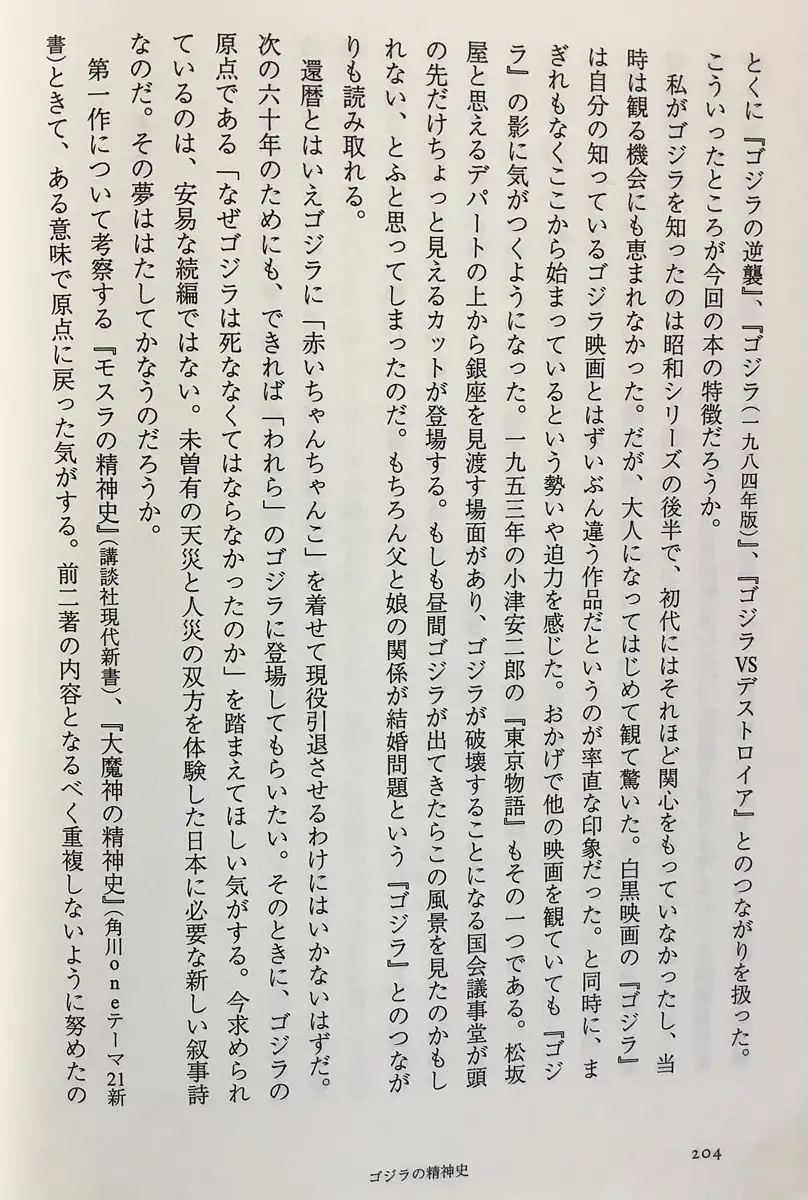
P 204
こういったところが今回の本の特徴だろうか。
Is this what makes this book so special?
私がゴジラを知ったのは昭和シリーズの後半で、初代にはそれほど関心をもっていなかったし、当時は観る機会にも恵まれなかった。だが、大人になってはじめて観て驚いた。白黒映画の『ゴジラ』は自分の知っているゴジラ映画とはずいぶん違う作品だというのが率直な印象だった。と同時に、まぎれもなくここから始まっているという勢いや迫力を感じた。おかげで他の映画を観ていても『ゴジラ』の影に気がつくようになった。一九五三年の小津安二郎の『東京物語』もその一つである。松坂屋と思えるデパートの上から銀座を見渡す場面があり、ゴジラが破壊することになる国会議事堂が頭の先だけちょっと見えるカットが登場する。もしも昼間ゴジラが出てきたらこの風景を見たのかもしれない、とふと思ってしまったのだ。もちろん父と娘の関係が結婚問題という『ゴジラ』とのつながりも読み取れる。
I first learned about Godzilla in the latter half of the Showa series, and I wasn’t that interested in the first generation, and I didn’t have the opportunity to see it at the time. However, when I saw it for the first time as an adult, I was surprised. My honest impression was that the black-and-white movie “Godzilla” was quite different from the Godzilla movies I was familiar with. At the same time, I felt a sense of momentum and power that was unmistakably starting from here. Thanks to this, I can now notice the shadow of “Godzilla” even when I watch other movies. One such example is Yasujiro Ozu’s “Tokyo Story” published in 1953. There is a scene overlooking Ginza from the top of a department store that appears to be Matsuzakaya, and a cut where the National Diet Building, which Godzilla will destroy, can be seen just above his head. I suddenly thought that if Godzilla had come out during the day, he might have seen this scenery. Of course, you can also see a connection to Godzilla, where the relationship between father and daughter is a marriage problem.
還暦とはいえゴジラに「赤いちゃんちゃんこ」を着せて現役引退させるわけにはいかないはずだ。次の六十年のためにも、できれば「われら」のゴジラに登場してもらいたい。そのときに、ゴジラの原点である「なぜゴジラは死ななくてはならなかったのか」を踏まえてほしい気がする。今求められているのは、安易な続編ではない。未曽有の天災と人災の双方を体験した日本に必要な新しい叙事詩なのだ。その夢ははたしてかなうのだろうか。
Even though it’s his 60th birthday, Godzilla can’t be forced to retire from active duty by wearing “red Chanchanko” [padded sleeveless kimono jacket; Japanese vest]. For the sake of the next 60 years, if possible, I would like “our” Godzilla to appear. At that time, I feel like they should consider the origin of Godzilla: “Why did Godzilla have to die?” What we need now is not a simple sequel. This is a new epic poem that is needed by Japan, which has experienced both unprecedented natural and man-made disasters. Will that dream come true?
第一作について考察する『モスラの精神史』(講談社現代新書)、『大魔神の精神史』(角川oneテーマ21新書)ときて、ある意味で原点に戻った気がする。前二著の内容となるべく重複しないように努めたので、伊福部昭の音楽や円谷英二の特撮の関係は手薄になったかもしれない。
In a sense, I feel like I’ve returned to the starting point when I look at the first work, “Mothra’s Spiritual History” (Kodansha Gendai Shinsho) and “Daimajin’s Spiritual History” (Kadokawa One Theme 21 Shinsho). I tried to avoid duplicating the contents of the previous two books as much as possible, so the relationship between Akira Ifukube’s music and Eiji Tsuburaya’s special effects may have been left out.
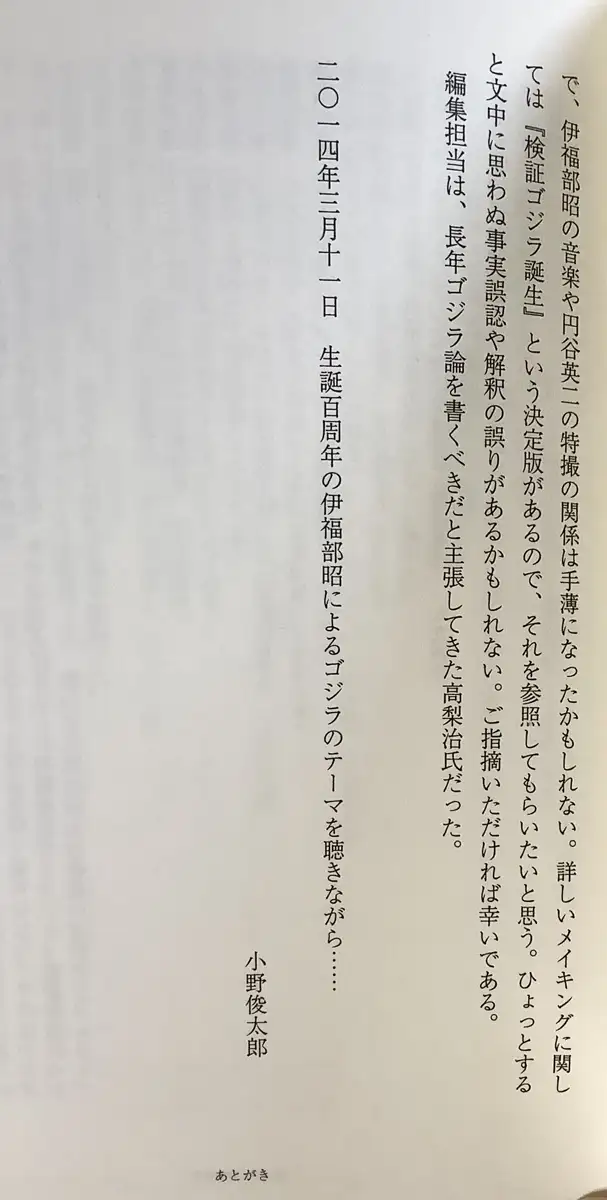
P 205
詳しいメイキングに関しては『検証ゴジラ誕生』という決定版があるので、それを参照してもらいたいと思う。ひょっとする文中に思わぬ事実誤認や解釈の誤りがあるかもしれない。ご指摘いただければ幸いである。
For more detailed information on the making of the story, there is a definitive version called “Verification of the Birth of Godzilla” [book], so please refer to it. There may be unexpected factual errors or misinterpretations in the text.I would be grateful if you could point them out. be.
編集担当は、長年ゴジラ論を書くべきだと主張してきた高梨治氏だった。
The editor in charge was Osamu Takanashi, who had long advocated for writing about Godzilla.
二〇一四年三月十一日生誕百周年の伊福部昭によるゴジラのテーマを聴きながら……
While listening to the Godzilla theme by Akira Ifukube on the 100th anniversary of his birth on March 11, 2014…
小野俊太郎
Shuntaro Ono
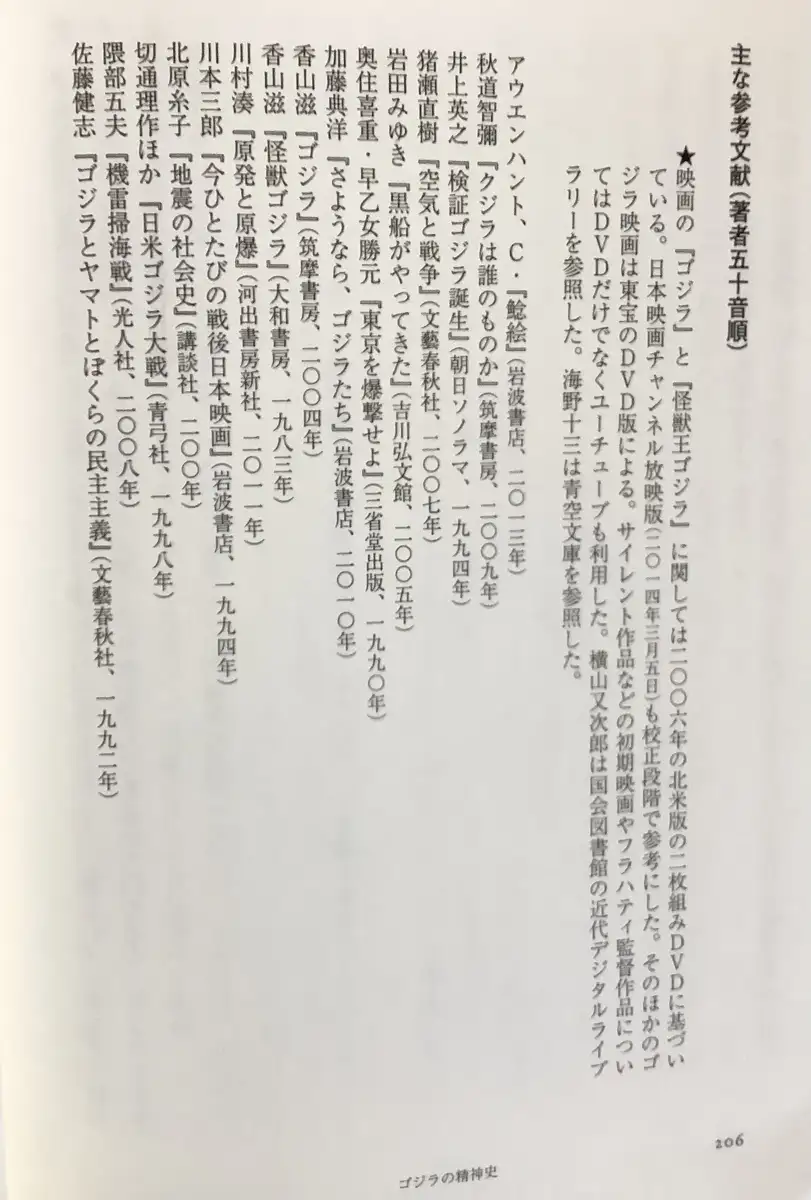
P 206
主な参考文献(著者五十音順)
Main references (author alphabetical order)
★映画の『ゴジラ」と「怪獣王ゴジラ」に関しては二〇〇六年の北米版の二枚組みDVDに基づいている。日本映画チャンネル放映版(二〇一四年三月五日)も校正段階で参考にした。そのほかのゴジラ映画は東宝のDVD版による。サイレント作品などの初期映画やフラハティ監督作品についてはDVDだけでなくユーチューブも利用した。横山又次郎は国会図書館の近代デジタルライブラリーを参照した。海野十三は青空文庫を参照した。
★The movies “Godzilla” and “Godzilla, King of the Monsters” are based on the 2006 North American double-disc DVD. The Japan Movie Channel broadcast version (March 5, 2014) was also referenced during the proofreading stage. Other Godzilla movies are from Toho’s DVD version. For early films such as silent films and films directed by Flaherty, he used not only DVDs but also YouTube. Matajiro Yokoyama referred to the National Diet Library’s Modern Digital Library. Juzo Unno referred to Aozora Bunko.
アウエンハント、C・「鯰絵』(岩波書店、二〇一三年)
秋道智彌『クジラは誰のものか』(筑摩書房、二〇〇九年)
井上英之『検証ゴジラ誕生』(朝日ソノラマ、一九九四年)
猪瀬直樹『空気と戦争』(文藝春秋社、二〇〇七年)
岩田みゆき「黒船がやってきた』(吉川弘文館、二〇〇五年)
奥住喜重・早乙女勝元「東京を爆撃せよ」(三省堂出版、一九九〇年)
加藤典洋『さようなら、ゴジラたち』(岩波書店、二〇一〇年)
川村湊『原発と原爆」(河出書房新社、二〇一一年)
川本三郎『今ひとたびの戦後日本映画』(岩波書店、一九九四年)
北原糸子『地震の社会史』(講談社、二〇〇年)
切通理作ほか「日米ゴジラ大戦』(青弓社、一九九八年)
隈部五夫『機雷掃海戦』(光人社、二〇〇八年)
佐藤健志『ゴジラとヤマトとぼくらの民主主義』(文藝春秋社、一九九二年)
Auenhant, C. “Catfish Pictures” (Iwanami Shoten, 2013)
Tomomi Akimichi, “Who does the whale belong to?” (Chikuma Shobo, 2009)
Hideyuki Inoue, “Verification of the Birth of Godzilla” (Asahi Sonorama, 1994)
Naoki Inose “Air and War” (Bungei Shunjusha, 2007)
Miyuki Iwata “The Black Ship Has Arrived” (Yoshikawa Kobunkan, 2005)
Yoshishige Okuzumi and Katsumoto Saotome, “Bomb Tokyo” (Sanseido Publishing, 1990)
Norihiro Kato “Goodbye, Godzilla” (Iwanami Shoten, 2010)
Minato Kawamura, “Nuclear Power and the Atomic Bomb” (Kawade Shobo Shinsha, 2011)
Saburo Kawamoto, “Once Upon a Time in Postwar Japanese Cinema” (Iwanami Shoten, 1994)
Itoko Kitahara, “Social History of Earthquakes” (Kodansha, 2000)
Risaku Kirimichi and others “Japan-U.S. Godzilla War” (Seikyusha, 1998)
Goo Kumabe, Minesweeping (Kojinsha, 2008)
Takeshi Sato, “Godzilla, Yamato, and Our Democracy” (Bungei Shunjusha, 1992)
香山滋『怪獣ゴジラ』(大和書房、一九八三年)
香山滋「ゴジラ』(筑摩書房、二〇〇四年)
Shigeru Kayama “Godzilla the Monster” (Yamato Shobo, 1983)
Shigeru Kayama “Godzilla” (Chikuma Shobo, 2004)
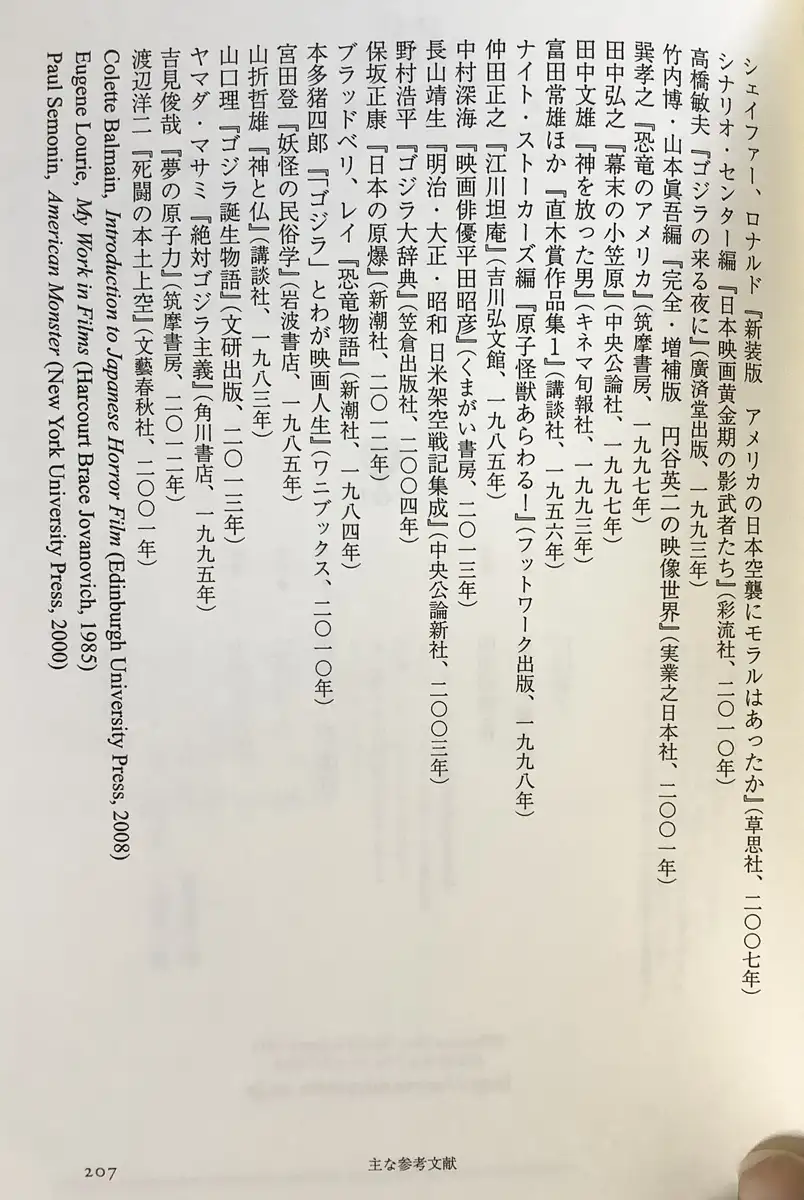
P 207
シェイファー、ロナルド『新装版アメリカの日本空襲にモラルはあったか』(草思社、二〇〇七年)
Schafer, Ronald, “Was there any morality in the new American air raids on Japan?” (Soshisha, 2007)
シナリオ・センター編『日本映画黄金期の影武者たち』(彩流社、二〇一〇年)
“Kagemusha of the Golden Age of Japanese Cinema” edited by Scenario Center (Sairyusha, 2010)
高橋敏夫『ゴジラの来る夜に』(廣済堂出版、一九九三年)
Toshio Takahashi, “On the Night Godzilla Comes” (Kosaido Publishing, 1993)
竹内博・山本眞吾編『完全・増補版円谷英二の映像世界』(実業之日本社、二〇〇一年)
Hiroshi Takeuchi and Shingo Yamamoto (eds.), “Complete and Expanded Edition of Eiji Tsuburaya’s Visual World” (Jitsugyo no Nihonsha, 2001)
巽孝之『恐竜のアメリカ』(筑摩書房、一九九七年)
田中弘之『幕末の小笠原』(中央公論社、一九九七年)
田中文雄『神を放った男』(キネマ旬報社、一九九三年)
富田常雄ほか『直木賞作品集1』(講談社、一九五六年)
ナイト・ストーカーズ編「原子怪獣あらわる!』(フットワーク出版、一九九八年)
仲田正之「江川坦庵』(吉川弘文館、一九八五年)
中村深海『映画俳優平田昭彦』(くまがい書房、二〇一三年)
長山靖生『明治・大正・昭和日米架空戦記集成』(中央公論新社、二〇〇三年)
野村浩平『ゴジラ大辞典』(笠倉出版社、二〇〇四年)
保坂正康『日本の原爆』(新潮社、二〇一二年)
ブラッドベリ、レイ『恐竜物語』(新潮社、一九八四年)
本多猪四郎『「ゴジラ」とわが映画人生』(ワニブックス、二〇一〇年)
宮田登『妖怪の民俗学』(岩波書店、一九八五年)
山折哲雄『神と仏』(講談社、一九八三年)
山口理『ゴジラ誕生物語』(文研出版、二〇一三年)
ヤマダ・マサミ『絶対ゴジラ主義』(角川書店、一九九五年)
吉見俊哉『夢の原子力』(筑摩書房、二〇一二年)
渡辺洋二『死闘の本土上空』(文藝春秋社、二〇〇一年)
Takayuki Tatsumi, “Dinosaur America” (Chikuma Shobo, 1997)
Hiroyuki Tanaka, “Ogasawara at the End of the Edo Period” (Chuokoronsha, 1997)
Fumio Tanaka, “The Man Who Released God” (Kinema Junposha, 1993)
Tsuneo Tomita et al. “Naoki Prize Collection 1” (Kodansha, 1956)
Night Stalkers, “The Beast from 20,000 Fathoms” (Footwork Publishing, 1998)
Masayuki Nakata “Egawa Tanan” (Yoshikawa Kobunkan, 1985)
Shinkai Nakamura “Movie Actor Akihiko Hirata” (Kumagai Shobo, 2013)
Yasuo Nagayama, “Meiji, Taisho, and Showa Japan-U.S. fictional war stories collection” (Chuokoron-Shinsha, 2003)
Kohei Nomura, “Godzilla Encyclopedia” (Kasakura Publishing, 2004)
Masayasu Hosaka, “Japan’s Atomic Bomb” (Shinchosha, 2012)
Bradbury, Ray, Dinosaur Story (Shinchosha, 1984)
Ishirō Honda, “Godzilla and My Movie Life” (Wani Books, 2010)
Noboru Miyata, “Folklore of Yokai” (Iwanami Shoten, 1985)
Tetsuo Yamaori, “God and Buddha” (Kodansha, 1983)
Osamu Yamaguchi “Godzilla Birth Story” (Bunken Publishing, 2013)
Masami Yamada, Absolute Godzillaism (Kadokawa Shoten, 1995)
Toshiya Yoshimi, “Nuclear Energy of Dreams” (Chikuma Shobo, 2012)
Yoji Watanabe, “Death Struggle Over the Mainland” (Bungei Shunjusha, 2001)
Colette Balmain, Introduction to Japanese Horror Film (Edinburgh University Press, 2008)
Eugene Lourie, My Work in Films (Harcourt Brace Jovanovich, 1985)
Paul Semolina, American Monster (New York University Press, 2000)

P 208
【著者】
小野俊太郎
・・・おの・しゅんたろう···
【author】
Shuntaro Ono
…Shuntaro Ono…
1959年、札幌生まれ。東京都立大卒業後、成城大学大学院博士課程中途退学。文芸評論家、成蹊大学などで教鞭もとる。
Born in Sapporo in 1959. After graduating from Tokyo Metropolitan University, he dropped out of the doctoral program at Seijo University Graduate School. He is a literary critic and also teaches at Seikei University.
主著に『本当はエロいシェイクスピア」(フィギュール彩8),
「『ギャツビー』がグレートな理由』(ともに彩流社)
「モスラの精神史』(講談社現代新書)、『大魔神の精神史』(角川oneテーマ21新書)、「〈男らしさ〉の神話』(講談社選書メチエ)、「社会が惚れた男たち」(河出書房新社)、「日経小説で読む戦後日本」(ちくま新書)、「デジタル人文学」(松柏社)、「フランケンシュタイン・コンプレックス」
Main author: “Actually Erotic Shakespeare” (Figur Aya 8),
“Why ‘Gatsby’ is Great” (both published by Sairyusha)
“The Spiritual History of Mothra” (Kodansha Gendai Shinsho), “The Spiritual History of the Great Demon God” (Kadokawa One Theme 21 Shinsho), “The Myth of Masculinity” (Kodansha Sensho Metier), “Men Who Loved Society” ( Kawade Shobo Shinsha), “Reading Postwar Japan in Nikkei Novels” (Chikuma Shinsho), “Digital Humanities” (Shohakusha), “Frankenstein Complex”
「明治百年もうひとつの1968』(ともに青草書房)他多数。
“Another 1968 in the 100 years of the Meiji era” (both published by Seiso Shobo) and many others.
フィギュール彩
ゴジラの精神史
二〇一四年五月二十五日 初版第一刷
二〇一四年七月九日 初版第二刷
Figure Aya
The Cultural history of Godzilla
May 25, 2014 First edition First printing
July 9, 2014 First edition Second printing
著者 ――― 小野俊太郎
発行者 ――― 竹内淳夫
印刷 ――― 明和印刷(株)
発行所 ――― 株式会社彩流社
製本 ――― (株)村上製本所
装丁 ――― 仁川範子
Author — Shuntaro Ono
Publisher — Atsuo Takeuchi
Printing — Meiwa Printing Co., Ltd.
Publisher — Sairyusha Co., Ltd.
Bookbinding — Murakami Bookbinding Co., Ltd.
Binding — Noriko Incheon
〒102-0071
東京都千代田区富士見2-2-2
電話:03-3234-5931
ファックス:03-3234-5932
E-mail: [email protected]
102-0071
2-2-2 Fujimi, Chiyoda-ku, Tokyo
Phone: 03-3234-5931
Fax: 03-3234-5932
著作権法違反となります。デジタル化等の複製は著作権法上での例外を除き、許諾を得て下さい。なお、無断でのコピー・スキャン事前にJPCA(電話03-3812-9424e-mail:[email protected])の複写(コピー)・複製、その他著作物の利用については、本書は日本出版著作権協会(JPCA)が委託管理する著作物です。
This is a violation of copyright law. Please obtain permission for digital reproduction, etc., except for exceptions under copyright law. Please note that this book is copyrighted by Nippon Shuppan Publishing Co., Ltd. (JPCA) (Tel: 03-3812-9424e-mail: [email protected]) before copying/scanning without permission. This is a copyrighted work commissioned and managed by the Copyright Association (JPCA).
© Shuntaro Ono, Printed in Japan, 2014
ISBN 978-4-7791-7013-3C0374
http://www.sairyusha.co.jp